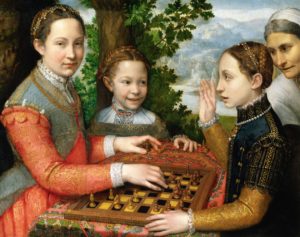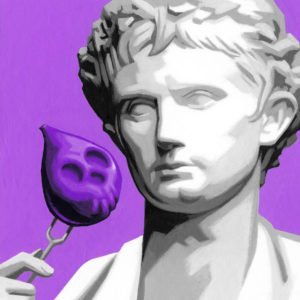From collecting ancient coins to Victorian taxidermy, we’ve found ingenious ways to fill our free time.
Wall Street Journal, April 16, 2020
It’s no surprise that many Americans are turning or returning to hobbies during the current crisis. By definition, a hobby requires time outside of work.

Sofonisba Anguissola, ‘The Chess Game’ (1555)
We don’t hear much about hobbies in ancient history because most people never had any leisure time. They were too busy obeying their masters or just scraping by. The earliest known hobbyists may have been Nabonidus, the last king of Babylonia in the 6th century B.C., and his daughter Ennigaldi-Nanna. Both were passionate antiquarians: Nabonidus liked to restore ruined temples while Ennigaldi-Nanna collected ancient artifacts. She displayed them in a special room in her palace, effectively creating the world’s first museum.
Augustus Caesar, the first Roman emperor, was another avid collector of ancient objects, especially Greek gold coins. The Romans recognized the benefits of having a hobby, but for them the concept excluded any kind of manual work. When the poet Ovid, exiled by Augustus on unknown charges, wrote home that he yearned to tend his garden again, he didn’t mean with a shovel. That’s what slaves were for.
Hobbies long continued to be a luxury for potentates. But in the Renaissance, the printing press combined with higher standards of living to create new possibilities for hobbyists. The change can be seen in the paintings of Sofonisba Anguissola, one of the first Italian painters to depict her subjects enjoying ordinary activities like reading or playing an instrument. Her most famous painting, “The Chess Game” (1555), shows members of her family engaged in a match.
Upper-class snobbery toward any hobby that might be deemed physical still lingered, however. The English diplomat and scholar Sir Thomas Elyot warned readers in “The Boke Named the Governour” (1531) that playing a musical instrument was fine ”‘for recreation after tedious or laborious affaires.” But it had to be kept private, lest the practitioner be mistaken for “a common servant or minstrel.”
Hobbies received a massive boost from the Industrial Revolution. It wasn’t simply that people had more free time; there were also many more things to do and acquire. Stamp collecting took off soon after the introduction of the world’s first adhesive stamp, the Penny Black, in Britain in 1840. As technology became cheaper, hobbies emerged that bridged the old division between intellectual and manual labor, such as photography and microscopy. Taxidermy allowed the Victorians to mash the macrabre and the whimsical together: Ice-skating hedgehogs, card-playing mice and dancing cats were popular with taxidermists.
In the U.S., the adoption of hobbies increased dramatically during the Great Depression. For the unemployed, they were an inexpensive way to give purpose and achievement to their days. Throughout the 1930s, nonprofit organizations such as the Leisure League of America and the National Home Workshop Guild encouraged Americans to develop their talents. “You Can Write” was the hopeful title of a 1934 Leisure League publication.







